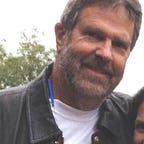R.I.P. Rail Mass Transit
A Rail Obituary from a Jan. 1, 2040 News Source
Rail Mass Transit lived a long and active life, and thanks to it’s offspring-computerized auto-trains, short-haul commuter-copters, hyperloops, and long-haul hydrogen jets, its spirit lives on
On a sad and somber day all over the world, the passing of Rail Mass Transit was mourned. Lovingly brought into this world by James Watt (inventor of the steam engine) and Richard Trevithick (inventor of the first working railroad in England in 1804), mass transit enjoyed a busy and fruitful life of over 200 years, finally succumbing to the most insidious diseases of old-age tech: cost overruns and obsolescence. Mass transit will be sorely missed by its greatest supporters-outdated futurists, site-seeing retired and wealthy with time on their hands, the highly subsidized poor and elderly, airborne diseases, subway thugs and thieves, and high-minded liberals. Its legacy will live on through its offspring, the many air, tunnel, and highway alternatives that it spawned, which will carry on the spirit, if not the inefficiencies, of the once-esteemed parent.
Mass transit (which was once known simply as a “Railroad”) was in its youth the creator of the mighty British and American Empires, spanning the American continent in the late 1860s and bringing civilization to unruly outposts such as India and Africa. During rail’s rowdy teen years, it was partially responsible for the spawning of the steel industry, and helped make fortunes for Andrew Carnegie, Cornelius Vanderbilt, and several other Robber Barons. In middle age, “Railroads” were given a face-lift, converting from messy steam to diesel electric and setting speed records in the late 30s. In its glorious hey-day that lasted until the 50s, elaborate railroads such as the California Zephyr, the Canadian Rocky Mountaineer, the South African Blue Train and the Istanbul-Vienna Orient Express were the domain of the rich and famous. Later, as urban sprawl spilled into congested suburbs, mass transit enjoyed a late-career boost as an electrified carrier of commuters, in cities from London to Tokyo to New York. It was thought that electrification might usher in an age of immortality for mass transit, which might cleanly and efficiently wean people off their dirty and noisy cars, thereby solving all sorts of congestion and pollution problems, but sadly it was not to be.
Mass transit was preceded in death by its relatives, the articulated bus, the dirigible, the luxury steamship, half the steel industry, and the Pontiac station wagon.
Rail mass transit enjoyed a late career-resurgence in the 2000s (reminiscent of the likes of Sean Connery, George Burns, Helen Mirren, and Betty White), when it was reimagined as a sort of magnetic-levitation thing moving at 300 mph or more through a series of futuristic tunnels and bridges. But these tunnels and technologies never quite materialized to a level where they were affordable or had enough reliable ridership to justify their relatively high rates of taxation (and low rates of adaptability). Then, the year 2020 hit and riders began to realize that the risks of diseases and muggings were not worth the waiting through frequent transit worker strikes and bus transfers in the rain. Rail M.T. was damaged further with the realization that Zoom, work-from-home, online learning, Amazon and other delivery services, offered the idea that one almost never needed to leave the comforts and safeties of home.
Rail mass transit is survived by smart-cars, hydrogen-powered air-travel, and hyperloops, which began to offset in comfort and safety everything that rail mass transit offered in public convenience and energy-efficiency. Even the latter two “strengths” of rail mass transit were challenged when in 2030, large hovercraft (basically large hydrogen-powered commuter drones which could take off or land anywhere) took over the wealthy commuter routes, hydrogen-powered jet aircraft took over 100–500 mile routes (previously thought to have been high-speed rail domains), and most city people started using the ubiquitous Smart Robotic-Ubers (or “SMUs”), which were discounted with public funds. These SMUs were sanitized and safeguarded against thieves and annoying street people, while their delivery vehicle relatives the “SURDs” (wait for it…Smart Uber Robotic Deliverers) delivered groceries and most other home freight. These robotic smart cars were not limited to Uber, as many auto makers offered these other tiny, stylish creatures in the form of highway models (which formed efficient highway “auto-trains” that travelled in packs, floating on mag-lev cushions while charging their batteries on highway conveyances with much higher passenger densities), while also converting to robotic rubber-tired travel over local roads. Hyperloops were built, mostly for urban centers to airport milk-runs through expensive tunnels, out of sight, out of mind. Of course, to satisfy the supporters of Donald Trump Jr (who narrowly lost the 2032 election even though he says it was “stolen” and is still contesting it in courts), one 12’ “Freedom” lane is mandated on each highway for the few remaining gas-powered RVs, Diesel Peterbilts, Hummers, Silverados, and F350s that mostly appear in Red State America.
There are no services or remembrances planned for Rail Mass Transit, as proponents would rather observe lengthy moments of silence while they set up their model train sets in their attics and basements, choosing to reflect upon what might have been.
In lieu of flowers, donations are requested for the many railroad museums that have sprung up around the world, and are also fighting for their financial lives, as most choose to experience old rail mass transit travel though virtual reality goggles.
(Author’s note: It pained me to write this article, as I spent most of my career supporting mass transit and also have a model train set in my attic)
ENJOY THESE OTHER TRANSPORTATION-RELATED ARTICLES BY VERN SCOTT:
